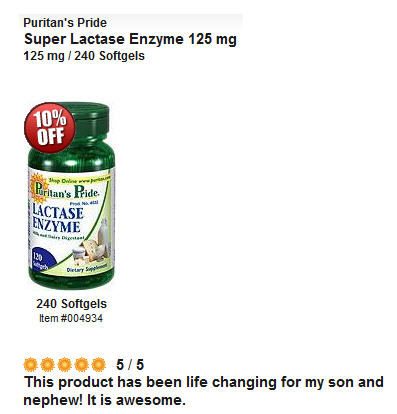Lactose Intolerance

Lactose intolerance is the inability to digest lactose, the sugar found naturally in milk and milk products. Those with lactose intolerance are unable to make enough lactase, an enzyme made in the small intestine that helps digest and absorb lactose into the bloodstream.
According to the National Institute of Diabetes and Digestive and Kidney Diseases (NIDDK), an estimated 30-50 million Americans have lactose intolerance. Most people with lactose intolerance have primary lactase deficiency, a condition in which the body’s production of lactase is gradually reduced as one get older. Gastrointestinal diseases such as celiac disease or Crohn’s disease and other conditions that adversely affect small intestine function can cause secondary lactase deficiency, as can bowel surgery and bacterial or viral infection. In some cases, this kind of lactose intolerance can be temporary. Though rare, an infant can be born with congenital lactose intolerance.
Others at high risk for lactose intolerance include
• African Americans, Indian Americans, and Asian Americans
• Premature infants (because high levels of lactase are produced in late pregnancy)
Symptoms
When an individual with lactose intolerance consumes lactose, the lactose that’s unabsorbed passes through the gastrointestinal tract and into the colon; bacteria in the colon use that lactose to form hydrogen gas. Symptoms can occur anywhere from 30 minutes to 2 hours after consuming lactose and can include Gas, Nausea, Bloating, Diarrhea and Stomach cramps or pain.
Because the symptoms of lactose intolerance can be similar to those that occur as a result of food allergies, other food intolerances, foodborne illnesses, or other conditions or diseases, a physician may perform three tests to diagnose lactose intolerance:
• Lactose tolerance test
• Hydrogen breath test
• Stool acidity test
Unlike those who are allergic to cow’s milk and need to avoid all milk products to prevent an allergic reaction, those with lactose intolerance can often consume small amounts of lactose – typically one-half cup, sometimes even as much as a cup – without experiencing symptoms. Age, ethnic background, and other factors determine if and how much lactose an individual can consume without causing symptoms.
Dietary Treatment
Although lactose intolerance is not dangerous, several dietary strategies can help individuals with the condition to limit or avoid symptoms.
Lactose is commonly found in dairy foods, such as cow’s milk, acidophilus milk, buttermilk, yogurt, cheeses (including American, Swiss, bleu, and Parmesan cheeses), cream, cream cheese, sour cream, ice cream, sherbet, and half-and-half. It can also be found in the following products:
• Bread and other baked goods
• Ready-to-eat breakfast cereals
• Breakfast and meal-replacement beverages
• Instant potatoes and soups
• Non-kosher lunch meats
• Salad dressings
• Candies and snack foods
• Pancake, brownie, cookie, and muffin mixes
Dietary supplements, over-the-counter antacid and other medications, and birth control pills can also contain lactose.
Reading ingredient lists on foods, beverages, dietary supplements, and prescription medication packages is essential to determine which items contain lactose (although amounts will vary). If any of the following are listed on the ingredients list, the product contains lactose. However, keep in mind that you do not need to avoid all lactose, just large amounts.
You can experiment with different amounts of lactose-containing foods and beverages, especially nutrient-dense options from the Milk category (including low-fat milk and yogurt). If you know you can’t tolerate the amounts of such foods recommended in MyPyramid, be sure to include key nutrients found in milk (including calcium, vitamin D, riboflavin, and protein) from other dietary sources to meet your daily nutrient needs. Alternatively, you can discuss supplements with your physician or a registered dietitian.
You can also pair small amounts of lactose-containing foods with foods rich in fiber or protein, which slows digestion, enhancing lactose absorption.
Although “lactose-free” or “lactose-reduced’ milk (such as Lact-Aid) and other dairy products are available, these terms are not officially defined by the FDA. Nevertheless, such products can help you reduce your overall lactose consumption by replacing similar lactose-containing foods and beverages.
Lactase enzymes are also sold as chewable tablets or pills (capsules); you can take these right before you consume lactose-containing foods and beverages to help your body better digest and absorb the lactose and avoid adverse symptoms. For children or infants with lactose intolerance, calcium-fortified soy milk or rice milk can substitute for cow’s milk.
Lactase is an enzyme (a protein) that breaks down lactose (the sugar in milk and milk products) into glucose and galactose.
Celiac disease is an inherited condition in which gluten – a protein found in grains such as wheat, barley, and rye – cannot be digested.
Crohn’s disease is a chronic inflammatory bowel disease that involves the small or large intestine that can cause diarrhea, malabsorption, and other symptoms.
A lactose tolerance test is one of several tests used to detect lactose intolerance in adults. It measures the ability of your intestines to break down lactose, the sugar found in milk and other dairy products. Multiple blood tests are taken before and after consuming a lactose-containing solution.
A hydrogen breath test is one of several tests used to detect lactose intolerance in adults. It measures how much hydrogen you breathe out and is a noninvasive test commonly used to detect lactose intolerance. Increased hydrogen levels indicate the body is adequately breaking down and absorbing lactose.
A stool acidity test is one of several tests used to detect lactose intolerance in children. It measures how acidic a stool sample is after ingesting a small amount of lactose.

